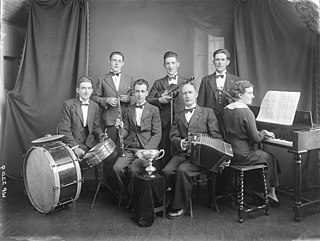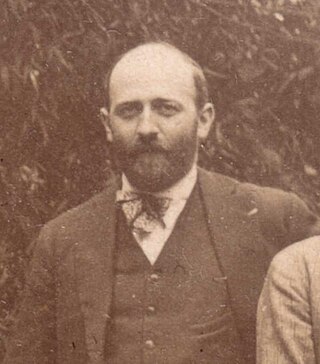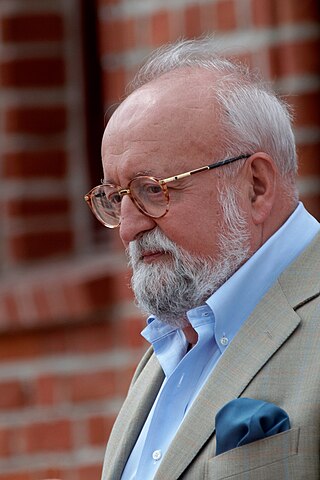Related Research Articles
The Symphony No. 6 in B minor, Op. 54 by Dmitri Shostakovich was written in 1939, and first performed in Leningrad on November 5, 1939 by the Leningrad Philharmonic Orchestra under Yevgeny Mravinsky.
The Symphony No. 8 in C minor, Op. 65, by Dmitri Shostakovich was written in the summer of 1943, and first performed on 4 November of that year by the USSR Symphony Orchestra under Yevgeny Mravinsky, to whom the work is dedicated. It briefly was nicknamed the "Stalingrad Symphony" following the first performance outside the Soviet Union in 1944.
The Symphony No. 10 in E minor, Op. 93, by Dmitri Shostakovich was premiered by the Leningrad Philharmonic Orchestra under Yevgeny Mravinsky on 17 December 1953. It is not clear when it was written. According to the composer, the symphony was composed between July and October 1953, but Tatiana Nikolayeva stated that it was completed in 1951. Sketches for some of the material date from 1946.

A septet is a formation containing exactly seven members. It is commonly associated with musical groups but can be applied to any situation where seven similar or related objects are considered a single unit, such as a seven-line stanza of poetry.

The Symphony No. 1 in C minor, Op. 68, is a symphony written by Johannes Brahms. Brahms spent at least fourteen years completing this work, whose sketches date from 1854. Brahms himself declared that the symphony, from sketches to finishing touches, took 21 years, from 1855 to 1876. The premiere of this symphony, conducted by the composer's friend Felix Otto Dessoff, occurred on 4 November 1876, in Karlsruhe, then in the Grand Duchy of Baden. A typical performance lasts between 45 and 50 minutes.
Concertino is the diminutive of concerto, thus literally a small or short concerto.

In music, an octet is a musical ensemble consisting of eight instruments or voices, or a musical composition written for such an ensemble.
In music, a nonet is a chamber music composition which requires nine musicians for a performance. The standard nonet scoring is for wind quintet, violin, viola, cello, and double bass, though other combinations are also found. Additionally, the term may apply to a group of nine musicians regardless of whether they are playing chamber music.

Alexis Fernand Félix Jean Rivier was a French composer of classical music in the neoclassical style.
Souvenir des Ming is the title of Jeffrey Ching's Fourth Symphony, which was composed in London between 14 January and 29 June 2002, and is in a single large movement lasting about thirty-five minutes. There is a further parenthetical title, Passacaglia and Fugue on Ming dynasty Fragments, which describes the actual thematic content and form of the work. In China the work is known as Minglü huiyin 明律回音.
Island Prelude is a chamber work composed by Joan Tower in 1988. Intended for oboist Peter Bowman of the Saint Louis Symphony Orchestra, it is originally scored for solo oboe and string orchestra.
Metropolis Symphony for Orchestra (1988–93) by American composer Michael Daugherty is a five-movement symphony inspired by Superman comics. The entire piece was created over the span of five years with separate commissions for each movement. Individual movements may be performed separately; however, it is preferred that the 41 minute symphony be performed in its entirety. MetropolisSymphony was premiered by the New Hampshire Symphony Orchestra, James Bolle conducting, in November 1993, at the Palace Theater in Manchester, New Hampshire. A connective narrative between movements was written and read by Jack Larson, who had played Jimmy Olsen on television in The Adventures of Superman. The orchestral version without narration was premiered by the Baltimore Symphony Orchestra, David Zinman conducting, in January 1994, at the Meyerhoff Concert Hall in Baltimore, Maryland.
In music, a decet—sometimes dectet, decimet, decimette, or even tentet—is a composition that requires ten musicians for a performance, or a musical group that consists of ten people. The corresponding German word is Dezett, the French is dixtuor. Unlike some other musical ensembles such as the string quartet, there is no established or standard set of instruments in a decet.

The Symphony No. 3 is a symphony in five movements composed between 1988 and 1995 by Krzysztof Penderecki. It was commissioned and completed for the centenary of the Munich Philharmonic. Its earliest version, Passacaglia and Rondo, premiered at the International Music Festival Week in Lucerne, Switzerland, on August 20, 1988. It was performed by the Lucerne Festival Orchestra and conducted by Penderecki. The full symphony premiered in Munich on 8 December 1995, performed by the Munich Philharmonic, again conducted by the composer.
October is a contemporary piece for concert band that was written by Eric Whitacre in 2000. Based on the guidelines as established by the authors of Teaching Music through Performance in Band, October is a Grade 5 piece.
The Symphony No. 4 by Walter Piston is a symphony dating from 1950.

Henri Frédien Tomasi was a French classical composer and conductor. He was noted for compositions such as In Praise of Folly, Nuclear Era and The Silence of the Sea.
Little (Chamber) Symphony No. 3, Op. 71 by Darius Milhaud is a work for chamber orchestra that was composed in 1921. The work is also known by the title Sérénade. This work is not to be confused with Milhaud's Symphony No. 3, which is known as Te Deum.
The Little (Chamber) SymphonyNo. 2, Op. 49, by Darius Milhaud is a three movement piece written for chamber orchestra, consisting of flute, English horn, bassoon, violin, viola, cello, and double bass. Milhaud composed this piece in 1918, one year after his first chamber symphony. It was fairly early in his composing career, while he was still employed as a secretary to the French ambassador to Brazil. Milhaud wrote this short symphony at sea, during a return voyage to France. Influences of Latin American rhythms and references to South America’s picturesque landscape are present throughout the piece.
The bassoon repertoire consists of pieces of music composed for bassoon as a principal instrument that may be performed with or without other instruments. Below is a non-exhaustive list of major works for the bassoon.
References
- ↑ Milhaud, Darius (1995). My Happy Life. M. Boyars. ISBN 978-0-7145-2957-8.
- ↑ Milhaud, Darius (June 1970). Notes without music: an autobiography. Da Capo Press.
- ↑ Positioning Milhaud's Late Chamber Music: Compositional 'Full Circle'?